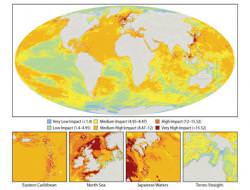If we needed any more proof that we as a race are damaging the worlds oceans, for the first time, our impact has been mapped by new study to be published in
Science
. It makes for uncomfortable viewing. Taking 17
known
types of human impact on marine ecosystems, this new research suggests that only 4% of the oceans are relatively untouched, whilst 40% are strongly impacted by human activity. The most impacted marine ecosystems include the North Sea, the South and East China Seas, the Caribbean, the Mediterranean, the Red Sea, the Gulf, the Bering Sea, the East coast of North America and in much of the western Pacific.
The new, high-resolution map of predominantly yellow regions and red dots could be mistaken for a global temperature map. However, this map is the first of its kind, mapping damaging human activity in the worlds oceans. At first glance it is obvious that most of the oceans have been affected in some way by the continued onslaught of human activity, with only the Polar Regions holding some of the most pristine and untouched seas. These are about the only portions of the map where the reach of human activity cannot grasp, but as global warming increases, the protective ice-sheets are likely to reveal more sea for humankind to exploit.
This new research was released today at the AAAS Annual Meeting and will be published in the February 15th issue of
Science
. The scientists behind this study are attending a special three day seminar on "Managing Threats to Marine Ecosystems". Although this work highlights the concerns about damage to our oceans, it may also aid future efforts to preserve areas of low human impact and will help us identify the worst affected regions.
" ." - Kimberly Selkoe of the National Center for Ecological Analysis and Synthesis (NCEAS) in Santa Barbara, CA and the University of Hawaii.
The map was created by dividing the Earths oceans into a grid of 1km×1km squares. The 17 contributing human factors were identified (including fishing, coastal development, fertiliser runoff and pollution from shipping traffic) and the extent at which each grid-point was influenced by each contributing factor was calculated. An "impact score" was then allocated at each location to rate how 20 different types of ecosystem are affected by each factor. It was found that an astonishingly high 41% of the oceans had medium-high to high impact ratings. 0.5% had very high impact ratings, representing 2.2 million square km (850,000 square miles).
Although these results may seem grim, it is the first chance scientists have had to evaluate the worst affected oceans, and many appear upbeat about managing the oceans better, preserving what is left of our pristine seas.
" . [...] ." - Ben Halpern, assistant research scientist at the University of California, Santa Barbara, research leader. "
Source: AAAS,
Guardian Online
 Universe Today
Universe Today
